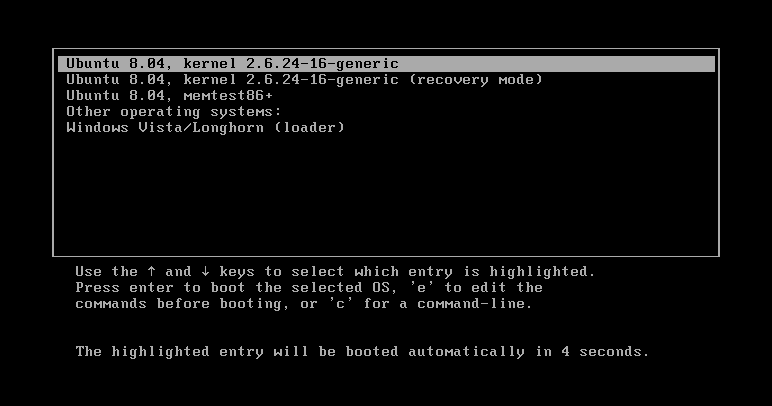|
Master Boot Record
A master boot record (MBR) is a special type of boot sector at the very beginning of partitioned computer mass storage devices like fixed disks or removable drives intended for use with IBM PC-compatible systems and beyond. The concept of MBRs was publicly introduced in 1983 with PC DOS 2.0. The MBR holds the information on how the disc's sectors are divided into partitions, each partition notionally containing a file system. The MBR also contains executable code to function as a loader for the installed operating system—usually by passing control over to the loader's second stage, or in conjunction with each partition's volume boot record (VBR). This MBR code is usually referred to as a boot loader. The organization of the partition table in the MBR limits the maximum addressable storage space of a partitioned disk to 2 TiB . Approaches to slightly raise this limit assuming 32-bit arithmetics or 4096-byte sectors are not officially supported, as they fatally break ... [...More Info...] [...Related Items...] OR: [Wikipedia] [Google] [Baidu] |
Logical Block Addressing
Logical block addressing (LBA) is a common scheme used for specifying the location of blocks of data stored on computer storage devices, generally secondary storage systems such as hard disk drives. LBA is a particularly simple linear addressing scheme; blocks are located by an integer index, with the first block being LBA 0, the second LBA 1, and so on. The IDE standard included 22-bit LBA as an option, which was further extended to 28-bit with the release of ATA-1 (1994) and to 48-bit with the release of ATA-6 (2003), whereas the size of entries in on-disk and in-memory data structures holding the address is typically 32 or 64 bits. Most hard disk drives released after 1996 implement logical block addressing. Overview In logical block addressing, only one number is used to address data, and each linear base address describes a single block. The LBA scheme replaces earlier schemes which exposed the physical details of the storage device to the software of the operating sy ... [...More Info...] [...Related Items...] OR: [Wikipedia] [Google] [Baidu] |
FDISK
In computing, the fdisk command-line utility provides disk-partitioning functions, preparatory to defining file systems. fdisk features in the DOS, DR FlexOS, IBM OS/2, and Microsoft Windows operating systems, and in certain ports of FreeBSD, NetBSD, OpenBSD, DragonFly BSD and macOS for compatibility reasons. In versions of the Windows NT operating-system line from Windows 2000 onwards, is replaced by a more advanced tool called diskpart. Similar utilities exist for Unix-like systems, for example, BSD disklabel. Implementations IBM PC DOS IBM introduced , Fixed Disk Setup Program version 1.00, with the March 1983 release of the IBM PC/XT, the first PC to store data on a hard disk, and the IBM Personal Computer DOS version 2.0. Version 1 could be used to create one FAT12 DOS partition, delete it, change the active partition, or display partition data. writes the master boot record, which supported up to four partitions. The other three were intended for other o ... [...More Info...] [...Related Items...] OR: [Wikipedia] [Google] [Baidu] |
PC DOS
PC or pc may refer to: Arts and entertainment * Player character or playable character, a fictional character controlled by a human player, usually in role-playing games or computer games * ''Port Charles'', an American daytime TV soap opera * Production code number, a designation used to identify television episodes * '' Pretty Cure'', a Japanese anime franchise Business and finance * Percentage (pc), numeric ratio signifier * Prime cost or variable cost * Principal Consultant, a management consulting position * Professional corporation, a type of corporate entity for licensed professionals (attorneys, architects, physicians, engineers, etc.) Organizations Businesses * Pearl-Continental Hotels & Resorts, a hotel chain in Pakistan * Pirelli & C. (stock symbol: PC) * President's Choice, a private label product brand of the Canadian supermarket chain Loblaw Companies ** PC Mobile, a Canadian mobile virtual network operator ** PC Optimum, a Canadian rewards program ** Pres ... [...More Info...] [...Related Items...] OR: [Wikipedia] [Google] [Baidu] |
Chain Loader
Chain loading is a method used by computer programs to replace the currently executing program with a new program, using a common data area to pass information from the current program to the new program. It occurs in several areas of computing. Chain loading is similar to the use of overlays. Unlike overlays, however, chain loading replaces the currently executing program in its entirety. Overlays usually replace only a portion of the running program. Like the use of overlays, the use of chain loading increases the I/O load of an application. Chain loading in boot manager programs In operating system boot manager programs, chain loading is used to pass control from the boot manager to a boot sector. The target boot sector is loaded in from disk, replacing the in-memory boot sector from which the boot manager itself was bootstrapped, and executed. Chain loading in Unix In Unix (and in Unix-like operating systems), the exec() system call is used to perform chain loadi ... [...More Info...] [...Related Items...] OR: [Wikipedia] [Google] [Baidu] |
Bootstrapping (computing)
In general, bootstrapping usually refers to a self-starting process that is supposed to continue or grow without external input. Etymology Tall boots may have a tab, loop or handle at the top known as a bootstrap, allowing one to use fingers or a boot hook tool to help pulling the boots on. The saying "to " was already in use during the 19th century as an example of an impossible task. The idiom dates at least to 1834, when it appeared in the ''Workingman's Advocate'': "It is conjectured that Mr. Murphee will now be enabled to hand himself over the Cumberland river or a barn yard fence by the straps of his boots."Jan FreemanBootstraps and Baron Munchausen '' Boston.com'', January 27, 2009 In 1860 it appeared in a comment on philosophy of mind: "The attempt of the mind to analyze itself san effort analogous to one who would lift himself by his own bootstraps." Bootstrap as a metaphor, meaning to better oneself by one's own unaided efforts, was in use in 1922. This metaphor ... [...More Info...] [...Related Items...] OR: [Wikipedia] [Google] [Baidu] |
Partition Table
Disk partitioning or disk slicing is the creation of one or more regions on secondary storage, so that each region can be managed separately. These regions are called partitions. It is typically the first step of preparing a newly installed disk, before any file system is created. The disk stores the information about the partitions' locations and sizes in an area known as the partition table that the operating system reads before any other part of the disk. Each partition then appears to the operating system as a distinct "logical" disk that uses part of the actual disk. System administrators use a program called a partition editor to create, resize, delete, and manipulate the partitions. Partitioning allows the use of different filesystems to be installed for different kinds of files. Separating user data from system data can prevent the system partition from becoming full and rendering the system unusable. Partitioning can also make backing up easier. A disadvantage is that it ... [...More Info...] [...Related Items...] OR: [Wikipedia] [Google] [Baidu] |
Disk Sector
In computer disk storage, a sector is a subdivision of a track on a magnetic disk or optical disc. Each sector stores a fixed amount of user-accessible data, traditionally 512 bytes for hard disk drives (HDDs) and 2048 bytes for CD-ROMs and DVD-ROMs. Newer HDDs use 4096-byte (4 KiB) sectors, which are known as the Advanced Format (AF). The sector is the minimum storage unit of a hard drive. Most disk partitioning schemes are designed to have files occupy an integral number of sectors regardless of the file's actual size. Files that do not fill a whole sector will have the remainder of their last sector filled with zeroes. In practice, operating systems typically operate on blocks of data, which may span multiple sectors. Geometrically, the word sector means a portion of a disk between a center, two radii and a corresponding arc (see Figure 1, item B), which is shaped like a slice of a pie. Thus, the ''disk sector'' (Figure 1, item C) refers to the intersection o ... [...More Info...] [...Related Items...] OR: [Wikipedia] [Google] [Baidu] |
Byte
The byte is a unit of digital information that most commonly consists of eight bits. Historically, the byte was the number of bits used to encode a single character of text in a computer and for this reason it is the smallest addressable unit of memory in many computer architectures. To disambiguate arbitrarily sized bytes from the common 8-bit definition, network protocol documents such as The Internet Protocol () refer to an 8-bit byte as an octet. Those bits in an octet are usually counted with numbering from 0 to 7 or 7 to 0 depending on the bit endianness. The first bit is number 0, making the eighth bit number 7. The size of the byte has historically been hardware-dependent and no definitive standards existed that mandated the size. Sizes from 1 to 48 bits have been used. The six-bit character code was an often-used implementation in early encoding systems, and computers using six-bit and nine-bit bytes were common in the 1960s. These systems often had memory wo ... [...More Info...] [...Related Items...] OR: [Wikipedia] [Google] [Baidu] |
Cross-platform
In computing, cross-platform software (also called multi-platform software, platform-agnostic software, or platform-independent software) is computer software that is designed to work in several computing platforms. Some cross-platform software requires a separate build for each platform, but some can be directly run on any platform without special preparation, being written in an interpreted language or compiled to portable bytecode for which the interpreters or run-time packages are common or standard components of all supported platforms. For example, a cross-platform application may run on Microsoft Windows, Linux, and macOS. Cross-platform software may run on many platforms, or as few as two. Some frameworks for cross-platform development are Codename One, Kivy, Qt, Flutter, NativeScript, Xamarin, Phonegap, Ionic, and React Native. Platforms ''Platform'' can refer to the type of processor (CPU) or other hardware on which an operating system (OS) or applicatio ... [...More Info...] [...Related Items...] OR: [Wikipedia] [Google] [Baidu] |
Partition Type
The partition type (or partition ID) in a partition's entry in the partition table inside a master boot record (MBR) is a byte value intended to specify the file system the partition contains or to flag special access methods used to access these partitions (e.g. special CHS mappings, LBA access, logical mapped geometries, special driver access, hidden partitions, secured or encrypted file systems, etc.). Overview Lists of assigned partition types to be used in the partition table in the MBR were originally maintained by IBM and Microsoft internally. When the market of PC operating systems and disk tools grew and liberated, other vendors had a need to assign special partition types to their products as well. As Microsoft neither documented all partition types already assigned by them nor wanted to maintain foreign assignments, third parties started to simply assign partition types on their own behalf in a mostly uncoordinated trial-and-error manner. This led to various confli ... [...More Info...] [...Related Items...] OR: [Wikipedia] [Google] [Baidu] |




